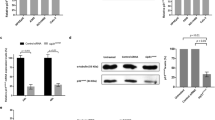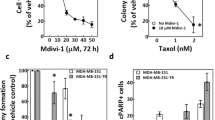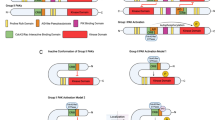Abstract
CKI p21 is a regulator of cellular responses to microtubule damage induced by drugs such as paclitaxel (PTX). It mediates the G1 4N arrest postactivation of the spindle assembly checkpoint and protects cancer cells against PTX-induced cytotoxicity. We demonstrated here that low doses of PTX that are unable to activate the spindle assembly checkpoint, upregulate p21 by a p53-dependent pathway and induce its translocation to the cytoplasm. This cytoplasmic accumulation of p21 resulted from an AKT-dependent p21 phosphorylation leading to an association of p21 with 14-3-3. Furthermore, the cytoplasmic p21 accumulation observed in PTX-treated cells was inhibited by LY 294002, a specific PI-3 kinase inhibitor or by the expression of a dominant-negative AKT mutant. However, the kinase activity of AKT was unchanged in PTX-treated cells, suggesting that low doses of PTX could regulate p21 phosphorylation via inhibition of its dephosphorylation. As a functional consequence, we found that cytoplasmic accumulation of the phosphorylated form of p21 prevents the inhibitory effect of p21, enabling these cells to escape to the p53-dependent Gl/S and G2/M checkpoints.
This is a preview of subscription content, access via your institution
Access options
Subscribe to this journal
Receive 50 print issues and online access
$259.00 per year
only $5.18 per issue
Buy this article
- Purchase on Springer Link
- Instant access to full article PDF
Prices may be subject to local taxes which are calculated during checkout





Similar content being viewed by others
References
Andreassen PR, Lohez OD, Lacroix FB, Margolis RL . (2001). Mol. Biol. Cell., 12, 1315–1328.
Asada M, Yamada T, Ichijo H, Delia D, Miyazono K, Fukumuro K and Mizutani S . (1999). EMBO J., 18, 1223–1234.
Barboule N, Chadebech P, Baldin V, Vidal S and Valette A . (1997). Oncogene, 15, 2867–2875.
Blagosklonny MV, Robey R, Bates S and Fojo T . (2000). J. Clin. Invest., 105, 533–539.
Blagosklonny MV, Schulte TW, Nguyen P, Mimnaugh EG, Trepel J and Neckers L . (1995). Cancer Res, 55, 4623–4626.
Blajeski AL, Phan VA, Kottke TJ and Kaufmann SH . (2002). J. Clin. Invest., 110, 91–99.
Cayrol C, Knibiehler M and Ducommun B . (1998). Oncogene, 16, 311–320.
Chen JG and Horwitz SB . (2002). Cancer Res., 62, 1935–1938.
el-Deiry WS, Harper JW, O'Connor PM, Velculescu VE, Canman CE, Jackman J, Pietenpol JA, Burrell M, Hill DE and Wang Y . (1994). Cancer Res., 54, 1169–1174.
Giannakakou P, Robey R, Fojo T and Blagosklonny MV . (2001). Oncogene, 20, 3806–3813.
Gorospe M, Wang X and Holbrook NJ . (1999). Gene Exp., 7, 377–385.
Harper JW, Adami GR, Wei N, Keyomarsi K and Elledge SJ . (1993). Cell, 75, 805–816.
Jordan MA, Wendell K, Gardiner S, Deny WB, Copp H and Wilson L . (1996). Cancer Res., 56, 816–825.
Khan SH and Wahl GM . (1998). Cancer Res., 58, 396–401.
Lanni JS and Jacks T . (1998). Mol. Cell. Biol., 18, 1055–1064.
Li W, Fan J, Banerjee D and Bertino JR . (1999). Mol. Pharmacol., 55, 1088–1093.
Li Y, Dowbenko D and Lasky LA . (2001). J. Biol. Chem., 276, 52.
Mitsuuchi Y, Johnson SW, Selvakumaran M, Williams SJ, Hamilton TC and Testa JR . (2000). Cancer Res., 60, 5390–5394.
Rossig L, Jadidi AS, Urbich C, Badorff C, Zeiher AM and Dimmeler S . (2001). Mol. Cell. Biol., 21, 5644–5657.
Sablina AA, Chumakov PM, Levine AJ and Kopnin BP . (2001). Oncogene, 20, 899–909.
Schmidt M, Lu Y, Liu B, Fang M, Mendelsohn J and Fan Z . (2000). Oncogene, 19, 2423–2429.
Sherr CJ and Roberts JM . (1995). Genes Dev, 9, 1149–1163.
Stewart ZA, Leach SD and Pietenpol JA . (1999a). Mol. Cell. Biol., 19, 205–215.
Stewart ZA, Mays D and Pietenpol JA . (1999b). Cancer Res., 59, 3831–3837.
Stewart ZA, Tang LJ and Pietenpol JA . (2001). Oncogene, 20, 113–124.
Torres K and Horwitz SB . (1998). Cancer Res., 58, 3620–3626.
Trielli MO, Andreassen PR, Lacroix FB and Margolis RL . (1996). J. Cell. Biol., 135, 689–700.
Vikhanskaya F, Vignati S, Beccaglia P, Ottoboni C, Russo P, D'lncalci M and Broggini M . (1998). Exp. Cell Res., 241, 96–101.
Waldman T, Lengauer C, Kinzler KW and Vogelstein B . (1996). Nature, 381, 713–716.
Waldman T, Zhang Y, Dillehay L, Yu J, Kinzler K, Vogelstein B and Williams J . (1997). Nat. Med., 3, 1034–1036.
Yu D, Jing T, Liu B, Yao J, Tan M, McDonnell TJ and Hung MC . (1998). Mol. Cell., 2, 581–591.
Zhou BP, Liao Y, Xia W, Spohn B, Lee MH and Hung MC . (2001). Nat. Cell. Biol., 3, 245–252.
Zugasti O, Rul W, Roux P, Peyssonnaux C, Eychene A, Franke TF, Fort P and Hibner U . (2001). Mol. Cell. Biol., 21, 6706–6717.
Acknowledgements
This work was supported by grants from Association pour la Recherche sur le Cancer.
Author information
Authors and Affiliations
Corresponding author
Rights and permissions
About this article
Cite this article
Héliez, C., Baricault, L., Barboule, N. et al. Paclitaxel increases p21 synthesis and accumulation of its AKT-phosphorylated form in the cytoplasm of cancer cells. Oncogene 22, 3260–3268 (2003). https://doi.org/10.1038/sj.onc.1206409
Received:
Revised:
Accepted:
Published:
Issue Date:
DOI: https://doi.org/10.1038/sj.onc.1206409
Keywords
This article is cited by
-
Platinum drugs and taxanes: can we overcome resistance?
Cell Death Discovery (2021)
-
PAWI-2 overcomes tumor stemness and drug resistance via cell cycle arrest in integrin β3-KRAS-dependent pancreatic cancer stem cells
Scientific Reports (2020)
-
Less understood issues: p21Cip1 in mitosis and its therapeutic potential
Oncogene (2015)
-
TACC3 depletion sensitizes to paclitaxel-induced cell death and overrides p21WAF-mediated cell cycle arrest
Oncogene (2008)
-
p21(WAF1)-mediated transcriptional targeting of inducible nitric oxide synthase gene therapy sensitizes tumours to fractionated radiotherapy
Gene Therapy (2007)



